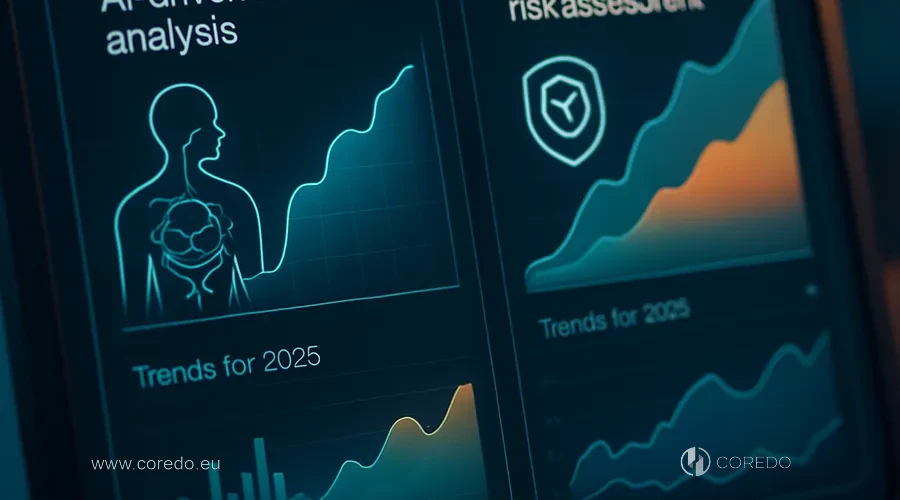Nikita Veremeev
20.10.2025 | 6 min read
Updated: 20.10.2025
Risks in the insurance industry play a key role in shaping the strategy of any insurance company and directly affect the stability and business development.
The variety of these risks requires clear classification, as understanding the structure of risks allows for more effective management and minimizes financial losses.
Classification of risks in insurance

COREDO’s experience shows that effective risk management in insurance begins with their precise classification:
- Financial risks: Inflation and the key interest rate in 2024–2025 remain decisive for the dynamics of insurance premiums and portfolio returns[rich_content:2]. For example, in the Czech Republic and Estonia an inflation increase of 6–8% led to a revision of property and liability insurance tariffs, and in the United Kingdom the Bank of England’s increase of the key rate forced insurers to adjust investment strategies. For corporate insurance this means the need for constant monitoring of macroeconomic indicators and flexible adaptation of insurance products.
- Operational risks: Digitalization and rising IT costs create new challenges: from technological failures to the need to protect client data under GDPR and similar Asian standards. Implementing new platforms without comprehensive testing can lead to failures in claims settlement and loss of customer trust.
- Regulatory risks: anti-money laundering measures (AML), tightening legislation in the EU, Singapore and Dubai, as well as sanctions restrictions require regular auditing of processes and revision of internal policies. Solutions developed by COREDO allow integrating AML services into insurance business processes, which is especially relevant for international groups.
- Cyber risks: According to Allianz’s estimate, in 2025 cyber insurance for small and medium-sized businesses will become a mandatory standard for companies working with personal data and online payments. COREDO’s practice confirms: cyberattacks lead not only to direct losses but also to regulatory fines if information protection requirements are not met.
Thus, current risks require not only specialized solutions but also consideration of regional specifics in insurance regulation.
Risks by region: EU, Asia, Africa
Regional specifics require an individual approach to managing insurance risks:
- EU: EU legislation in the insurance field (IDD, Solvency II, AMLD6) tightens requirements for transparency, capital and testing customers’ understanding of insurance products. The implementation of digital technologies in Europe speeds up processes but increases vulnerability to cyber threats.
- Asia: In Singapore and Hong Kong regulators are actively implementing sandboxes for insurance innovations; on the other hand they require strict compliance with AML and KYC. In Southeast Asian countries demand for life and non-life insurance is growing, but low financial literacy among customers increases operational risks.
- Africa: Main challenges: currency instability, weak infrastructure, a large informal sector. Here corporate insurance and credit risk insurance require special attention to local partners and adaptation of products to market specifics.
the impact of sanctions and digital transformation is manifested in the need to restructure supply chains, change banking partners and implement new IT solutions to monitor transactions and data.
How to adapt to changes in the insurance industry?

Adapting to changes in the insurance industry is becoming increasingly important in the face of new economic, technological and regulatory challenges. Insurance companies are confronted with the need to revise risk management approaches, implement digital solutions and develop new insurance products to meet modern requirements.
Next, we will look at the key directions for adaptation, beginning with modern risk management methodologies.
Risk management: modern methodologies
The COREDO team has implemented a number of strategies for clients in the EU and Asia that have proven effective:
- financial risks: Use of stress testing and scenario analysis to assess the impact of inflation and the key interest rate on insurance premiums and profitability. For example, when launching comprehensive insurance programs for businesses in the Czech Republic and Cyprus, we integrated dynamic pricing models that take macroeconomic factors into account.
- Cyber risks: For clients in Singapore and the United Kingdom, COREDO implemented multi-level monitoring and incident response systems, as well as regular audits of IT infrastructure. This helps minimize losses from cyberattacks and meet regulators’ requirements.
- Portfolio management: In an unstable market, it is important to apply ALM (Asset-Liability Management) methods and diversify the portfolio of insurance products. Our experience at COREDO has shown that regular portfolio rebalancing and the implementation of ROI metrics in the insurance business make it possible to quickly identify ineffective areas and reallocate resources.
Digital technologies and innovations: role and impact
Digital transformation has become an integral part of adapting insurance business:
- Reducing insurance losses: Implementing automated claims settlement systems and digital platforms for underwriting speeds up processes and reduces the likelihood of errors. COREDO’s solutions for clients in Estonia and Slovakia include the integration of AI modules for claims assessment and fraud detection.
- Customer experience: Using tools for testing customers’ understanding of insurance products (customer suitability testing) and personalized dashboards increases client trust and reduces the risk of misunderstandings of contract terms.
- IT costs and scaling: Under sanctions and restrictions on access to foreign IT services, COREDO helped clients in Dubai and Singapore implement local cloud solutions and build a fault-tolerant IT architecture, which ensured uninterrupted operations and data protection.
Regulatory compliance and AML procedures
COREDO’s comprehensive support covers the entire compliance cycle:
- AML services: Implementing a risk-based approach, automating KYC/AML procedures, regular staff training and policy audits help minimize regulatory risks. For international insurance groups in the EU and Asia, the COREDO team developed solutions to integrate AML into underwriting and payment processes.
- Registration of legal entities: When entering new markets (for example, registering an insurance business in Singapore or Cyprus), special attention is paid to preparing constituent documents, licensing and interacting with local regulators. COREDO’s practice confirms: timely registration and obtaining all permits: the key to stable operations in a complex regulatory environment.
- Adapting to legislative changes: Continuous monitoring of changes in the legislation of the EU, Asia and the Middle East, as well as integrating new requirements into business processes, allow COREDO clients to avoid fines and reputational losses.
New insurance products and trends 2025

New insurance products and trends 2025 are shaping entirely new standards of insurance protection for businesses and executives. Corporate insurance and directors’ liability insurance are responding to the market’s demand for digitalization, personalization and more flexible solutions sought after amid rapid industry changes.
Corporate insurance and directors’ liability insurance
In a context of economic instability, corporate insurance takes on new significance:
- D&O: Directors’ liability insurance is becoming the standard for companies operating in international supply chains. COREDO’s experience in the Czech Republic and the United Kingdom shows that implementing D&O helps minimize corporate risks related to management errors and regulatory claims.
- Comprehensive programs: For clients in the EU and Asia, the COREDO team develops comprehensive insurance programs that combine property, liability, cyber and credit risk insurance. This approach provides businesses protection against systemic and specific threats.
Cyber insurance for small and medium-sized businesses
- Outlook: In 2025, cyber insurance is becoming one of the fastest-growing segments, especially in Europe and Asia. The adoption of digital technologies and the increase in online transactions make cyber risks critical even for small companies.
- Regional specifics: In Singapore and Estonia, cyber insurance is integrated with personal data protection programs, while in African countries it is combined with solutions for managing infrastructure risks. The COREDO team adapts insurance products to the requirements of local regulators and the specifics of the business.
COREDO also offers solutions in the areas of credit risk insurance and accident insurance, which are becoming relevant for businesses in changing economic conditions.
Credit risk insurance and accident insurance
- Credit risks: In conditions of reduced lending and rising delinquencies, credit risk insurance becomes a vital tool for protecting working capital. COREDO helps clients in the EU and Asia choose optimal insurance products, taking into account the dynamics of economic activity and the specifics of tax incentives.
- Accidents: New products to protect businesses from accidents include expanded coverage for employees, as well as integration with life and non-life insurance programs. This approach helps reduce overall insurance losses and increase employee loyalty.
Practical advice for entrepreneurs and managers

Practical advice for entrepreneurs and managers becomes particularly relevant in a rapidly changing economic environment. For the insurance business, this means the need to timely adapt strategies, processes and products in order not only to maintain positions but also to effectively respond to new market challenges.
Below is a checklist of key steps to help minimize risks and increase the resilience of an insurance company.
Checklist for adapting an insurance business to economic changes
- Conduct regular audits of the insurance product portfolio using ALM and stress testing.
- Implement digital solutions to automate claims settlement and underwriting.
- Integrate AML and KYC procedures at all stages of work with clients and counterparties.
- Monitor legislative changes in key regions and promptly adapt internal policies.
- Use comprehensive insurance programs to protect business assets and minimize systemic risks.
Choosing insurance products and partners
- Evaluate not only the cost but also the scope of coverage, the availability of D&O and cyber insurance.
- Prefer partners with experience in your industry and region.
- Verify that insurance products comply with legal requirements and AML standards.
Profitability of the insurance business during high inflation
- Use dynamic pricing and regularly review rates.
- Implement ROI assessment tools for each insurance product.
- Diversify the portfolio and invest in innovative insurance solutions.
Portfolio management and ROI assessment
- Implement performance metrics for insurance programs: loss ratio, customer retention rate, average settlement time.
- Use dashboards to monitor key indicators in real time.
- Regularly test customers’ understanding of insurance products to reduce operational risks.
Key findings and development prospects

Risks in the insurance industry are becoming increasingly complex and interconnected: inflation, digitalization, sanctions, tighter AML and new regulatory requirements demand flexibility and strategic thinking from businesses. COREDO’s practice shows that only a comprehensive approach to insurance risk management, integration of digital technologies and continuous adaptation to changes in legislation allow not only to protect the business but also to find new growth opportunities.
In 2025 the key trends will include the development of cyber insurance, growing demand for D&O and comprehensive insurance programs, as well as the introduction of innovations in underwriting and claims settlement. For entrepreneurs and executives seeking to scale their business in Europe, Asia and the CIS, choosing a reliable partner and investing in digital transformation become decisive factors for success.
Table of risks and adaptation methods by region
| Region | Key risks | Effective adaptation methods |
|---|---|---|
| EU | Inflation, sanctions, cyber risks | ALM, D&O, digital platforms, AML |
| Asia | Cyber threats, regulatory barriers | Sandboxes, IT localization, KYC/AML |
| Africa | Currency and infrastructure risks | Local partners, product adaptation |
Infographics: what it is and how to use it
- Growth of the share of cyber insurance in the portfolios of European and Asian insurers from 2023 to 2025 (according to Swiss Re, Allianz).
- Dynamics of insurance premiums and the impact of inflation on the cost of corporate insurance in the EU and Asia.
- Top 5 factors affecting the insurance market: inflation, key interest rate, digitalization, sanctions, AML.
Links to legislation and AML practices
- Solvency II, IDD (Insurance Distribution Directive), AMLD6 (EU)
- MAS Notice 626 (Singapore)
- FCA Handbook (United Kingdom)
- FATF Guidance on AML in Insurance Sector
If you are looking for a strategic partner for registering an insurance business, obtaining licenses, implementing AML and managing risks in the EU, Asia or the CIS, COREDO’s experience and our comprehensive solutions will help your business not only adapt but also reach a new level of efficiency.